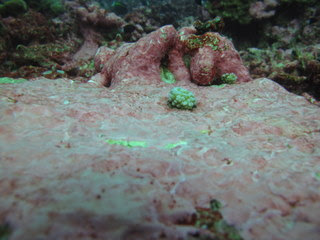



 We are headed back to Fiji, a 5+ -day trip (photo of us underway by Larry Madin). After being anchored for three days at our last stop in the Phoenix Islands, we all felt surge of recognition when we left the island of Orona’s lee and the ship motion began: here we go again…
We are headed back to Fiji, a 5+ -day trip (photo of us underway by Larry Madin). After being anchored for three days at our last stop in the Phoenix Islands, we all felt surge of recognition when we left the island of Orona’s lee and the ship motion began: here we go again…During the trip back, the work has changed, but not stopped. Accommodating to the roll, you can get a lot done.
There’s packing: everyone’s gear and possessions need to be returned to the huge number of Pelican cases and duffel bags we came with (photo by Larry Madin)
And there’s science: Greg Stone, leader of the expedition, has called science meetings each morning, to discuss the preliminary findings and the way to proceed from this point. PIPA has been nominated as a World Heritage Site, and the day we arrive in Fiji, scientists aboard will be interviewed about what they have observed about the site.
» View NOAA News Release (World’s Largest Marine Protected Areas Sign Partnership Agreement)
Scientists are writing summaries of their work. People are discussing collaborative papers and further work on samples they are carrying back– coral samples for scientists at WHOI and other institutions and for genetic analysis in labs at Boston University and elsewhere, samples of sea cucumbers from sandy reef flats for colleagues and students at home – a long list of items colleagues requested from scientists on this expedition! The diver-photographers are going over their shots, labeling, and sharing. And National Geographic photographers Brian and Jeff are working with their photos.
I asked Larry about the plankton work, and he said, “The water column is PIPA’s largest habitat. Only 0.006% of the PIPA protected area is land. All else is open ocean over deep-sea floor – waters that make the large scale physical, chemical and biological context for the reefs, including food resources as plankton, and pelagic fishes that are part of the larger ecology of the reefs.
“Single-celled algae create food from sunlight, zooplankton eat these cells and are the link in the food chain to larger animals like fish, turtles, and whales. We had no information about the diversity or abundance of the zooplankton in PIPA waters, and that’s what I came on this expedition to begin to find out.
“We’ve made a preliminary survey of the zooplankton here. For small animals we towed a plankton net, and we’re bringing the samples home for identification – we expect to find small crustaceans, snails and worms, and we may see larval stages of invertebrates or fish. We used scuba to dive in open water and collect larger and more fragile gelatinous creatures – the ‘jelly animals’ that are my specialties, are usually too delicate to be collected in nets. This first look at the community of zooplankton here will add to our understanding of the total ecosystem of PIPA, and will provide data for the Census of Marine Zooplankton, a world-wide program to identify planktonic animals from all the world’s oceans, as part of the global Census of Marine Life.”
This trip has been an astounding opportunity for Larry and me to see a part of the ocean we hadn’t been to, to take a preliminary look at the plankton, and to see some of the most remote coral reefs in the world. We’ve spent hours talking with shipmates who study and hope to preserve the reefs – and with Tukabu and Tuake, about Kiribati’s rich ocean resources and PIPA, a great gift their nation has given the world.
Scientists aboard are entirely committed to saving reef ecosystems – in trouble all over the world. As I write, several are talking about how aquaculture might coexist with natural coastal areas in nations now using aquaculture to feed a global trade in seafood their local people cannot afford to buy. One way forward is marine protected areas such as PIPA.
A wrap-up wouldn’t be complete without mentioning the Nai’a (photos by Larry Madin)– our 110 ft live-aboard motor-sailer diveboat, its owner Rob Barrel, who cares immensely about the reefs and sharks (photos by Jim Stringer), and its remarkable Fijian crew of divers, divemasters, and support people. Jonathan, the captain; Mo and Koroi, who drove the skiffs and helped with diving; Sam and Brigitte who dove with the group and made videos; Penni, who fed us; Suli and Wally and John who took care of the boat and us, and all who took care of dive gear, filled tanks, ran the engines, put up the sails, and sang almost every night out on deck. We won’t forget the corals, fish, the sharks, the aquamarine water or the sunsets that filled this amazing trip to the Phoenix Islands.













































